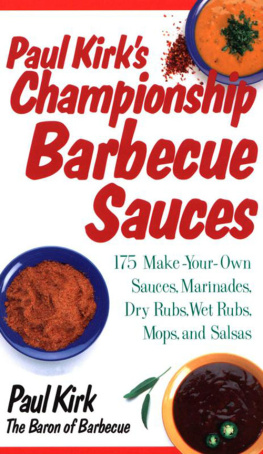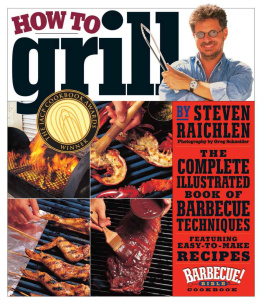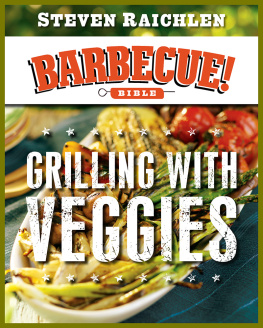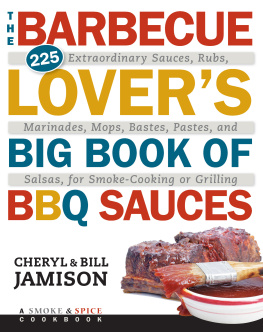BARBECUE!
BIBLE
SAUCES
RUBS, and
MARINADES
BASTES, BUTTERS & GLAZES
by STEVEN RAICHLEN
Illustrations by Ron Tanovitz
WORKMAN PUBLISHING, NEW YORK
ACKNOWLEDGMENTS
To Barbara
Who lights my fire

The most pleasurable part of writing a book is thanking the people who helped make it possible. This one is built on the wisdom of thousands of pit masters and grill jockeys around the world.
In particular, I would like to thank:
My wife: Barbara
My agent: Angela Miller
My stepson and recipe tester: Jake Klein
Recipe tester: Elida Proenza
Editorial assistant: Heather Short
Photographer: Greg Schneider
Web master: Benjamin Wilchfort
My friends at Workman Publishing:
Editor extraordinaire: Suzanne Rafer
Publisher: Bruce Harris
Copy editor: Susan Derescky
Editorial assistant: Kylie Foxx
Designers: Paul Hanson and Lisa Hollander
Sales and licensing folks: Janet Harris, Jenny Mandel, Pat Upton
Publicity: Ellen Morgenstern and Jim Eber
And, of course, the one and only Peter Workman
Barbecue buddies:
Karen Adler of Pig Out Publications, Jim Budros, Oklahoma Joe Davidson, Ardie Davis, Dr. Rich Davis, Judith Fertig, Cal Fussman (Perfect Man), Ron Harwell, Brian Heinecke, Don Hysco, Jake Jacobs, The Kansas City Barbecue Society, Paul Kirk, Ted and Donna McClure, Jack McDavid, Janeyce Michel-Cupito, Donna Myers, Lindsay Shannon, David Sparrow, Skip Steele, Jim Trim Tabb, Charlie Trotter, and Carolyn Wells
CONTENTS



BUILDING BETTER BARBECUE
THE FLAVOR FACTOR
Theyre the foundation of world-class barbecue, the cornerstones on which unforgettable live-fire flavors are built. Im talking about the barbecue sauces, rubs, spice pastes, marinades, and mops that transform ordinary grilled meats and seafood into barbecue of the highest distinction. Theyre the essential seasonings that give grilled fare its character, personality, and very soul.
And theyre about to make you, the grill master, look like a million bucks.
One things for sure: Never has interest been keener in these not-so-subtle boosters of flavor. Spice sales are skyrocketing (up 62 percent in the last decade); and chili consumption has gone through the roof (188,000 tons at the very end of the millennium versus 105,000 tons in 1980), as Americans hunger for big-flavor foods that pack a wallop to the taste buds. In the realm of barbecue sauces alone, there are now more than 750 different commercially bottled varieties to choose from.

Despite the proliferation of barbecue sauces, rubs, marinades, and bastes, a great deal of confusion surrounds them. Whats the difference between a dry rub and a wet rub? When do you use a spice mix or a marinade? How long should you marinate your favorite meat or seafood? Whats the best way to baste or glaze? When should you apply the barbecue sauce? What do grill masters in other countries serve with grilled fare? How do the pros use rubs, marinades, and sauces to make championship barbecue every time?
This book explores the answers to these and other questions. For rubs, marinades, and sauces can make all the difference between serviceable grilled fare and world-class barbecue. Theres no shortage of commercial rubs, marinades, and barbecue sauces, and many will produce tasty barbecue. But if you want to achieve truly extraordinary results and express your culinary creativity to its fullest, at some point youll want to concoct your own.
Before we begin, a word about nomenclature. Oceans of ink have been spilled about the true meaning of barbecue. To some, its a catch-all term for anything cooked on a grill or pit. For others, barbecue refers to a specific type of meat (usually pork or beef) cooked by means of an equally distinctive cooking techniquelong, slow smoking with indirect fire. Yet others use the word barbecue to describe a cooking device (the so-called barbecue grill), a dish (pulled pork in North Carolina, for example, or brisket in Texas), or even a cookout.
In Miami, where I live, and on the American East and West Coasts in general, barbecue refers to any sort of food cooked with live fire. The method can be direct or indirect. This is the way I use the term in this book. I acknowledge that this isnt the way certain Texans, Kansans, and North Carolinians see matters, but for the sake of expediency, please humor me.
A STRONG FOUNDATION
Anyone can grill a steak or smoke a brisket. But cooking great barbecue involves an intimate knowledge of fuels and fire control as well as considerable expertise in using rubs, marinades, bastes, glazes, and sauces. In a way, the process is similar to building a house. The contractor has to know how to select a site, dig a foundation, build a frame, do the finishing work, paint, decorate, and landscape, using the proper tools and construction methods.

Building great barbecue as well, requires the right tools (smokers and grills), the proper methods (flame and heat control), a solid foundation (the rubs and marinades), good finish work (the bastes and glazes), attractive paint (the barbecue sauce), and pleasing landscaping (the salsas, relishes, chutneys, mustards, ketchups, and other condiments served as accompaniments). Get these elements right and your barbecue will be very much at home on the plate, on your tongue, and in your belly.
Not every dish requires all of these elements. That would be overkill. But a lot of traditional American barbecue (Kansas Citystyle ribs, for example) features a soak in a marinade; a dusting with a rub; a generous basting during cooking; a glaze during the final grilling; and a barbecue sauce for serving.
Some years ago, I had the opportunity to watch one of the most decorated teams on the American competition barbecue circuitApple City from Murphysboro, Illinoisprepare the ribs that won the grand championship at the Memphis in May World Championship Barbecue Cooking Contest. I was exhausted just watching the process! Each rack of ribs was painstakingly trimmed with a scalpel, then marinated overnight in a tenderizing bath of lemon juice and apple cider. No baby was ever toweled dry more gently than those ribs or more lovingly dusted with baby powder than the way the boys from Apple City sprinkled the bones with an eighteen-ingredient spice mix affectionately dubbed Magic Dust. (The formula is such a closely held secret, quipped the team captain, Pat Burke, that no team member knows more than three of the ingredients.)
Once in the smoker, the ribs were sprayed repeatedly with apple cider to keep them moist, reseasoned with rub for extra flavor, and varnished with a barbecue sauceflavored with apple cider (what else?!)to give them a handsome sheen. Come time for the judging, the sauce was served on the side to allow the judges to experience the extraordinary flavor of the ribs without distraction.





![Raichlen - Barbecue Sauces, Rubs, and Marinades—Bastes, Butters & Glazes, Too [eBook - Biblioboard]](/uploads/posts/book/229830/thumbs/raichlen-barbecue-sauces-rubs-and.jpg)






